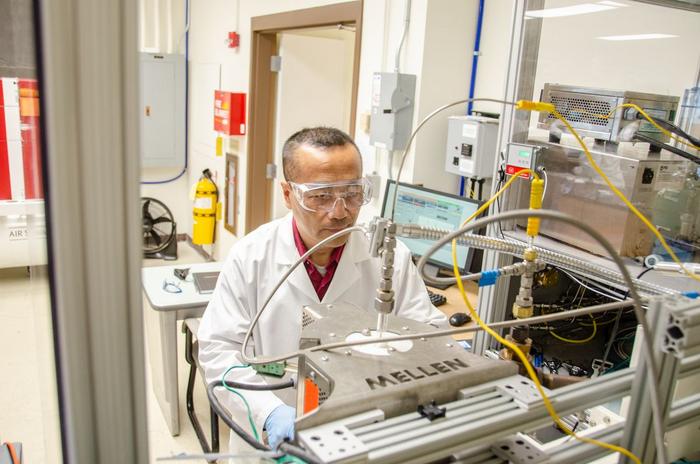West Virginia University engineers have secured $3 million in U.S. Department of Energy funding to research a new chemical reactor system that uses microwaves to reduce industrial heat and carbon emissions.

Credit: WVU Photo/J. Paige Nesbit
West Virginia University engineers have secured $3 million in U.S. Department of Energy funding to research a new chemical reactor system that uses microwaves to reduce industrial heat and carbon emissions.
The first-of-its-kind technology would allow industrial facilities to simultaneously produce ethylene and ammonia, two chemicals that contribute significantly to greenhouse gas emissions, within a single microwave reactor. That device uses heat from microwave electromagnetic radiation to carry out chemical reactions.
The carbon-negative process would reduce energy consumption by 85%.
Lead researcher John Hu is the Statler Chair in Engineering for Natural Gas Utilization at the WVU Benjamin M. Statler College of Engineering and Mineral Resources, a professor of chemical engineering and director of the WVU Center for Innovation in Gas Research and Utilization. Hu emphasized that, while the study focuses on ethylene and ammonia production, the technology can be broadly applied to many other industrial processes that need heat to work.
Various industries need heat to do everything from removing moisture and creating steam to melting plastics and treating metals. According to the DOE, industrial heat accounts for approximately 9% of U.S. emissions. The heat used in conventional industrial processes is typically produced through carbon-intensive methods like combustion. When that heat transfers through different materials like reactor walls, coils and catalysts, it loses energy in the process, undermining sustainability as well as efficiency.
Hu explained that because the microwave reactor can start up and shut down within minutes, it can draw on intermittent sources of renewable energy for power. A traditional reactor requires steady, reliable energy sources and cannot run on renewables like solar or wind energy.
“Using microwaves allows us to control the heat delivery very precisely, so that we can quickly switch between heating the reactor to produce methane and cooling it to synthesize ammonia,” Hu said. “By using the hydrogen from methane coupling, we remove the need for a hydrogen production step in ammonia synthesis and make the process much more friendly to the environment.”
Also contributing to the research are WVU assistant professors Yuxin Wang and Yuhe Tian, and Srinivas Palanki, professor and chair of the Statler College Department of Chemical and Biomedical Engineering.
Their work builds on existing WVU patents and research demonstrating microwave reactors operate at significantly lower temperatures than traditional methods for industrial heating and produce fewer undesirable byproducts. The approach enables operation of the reactor in “non-equilibrium mode,” which increases efficiency and improves product yields.
Hu said the technology is “precise, allowing us to vary the power and frequency of the microwave pulses over time, rapidly switching between high and low temperatures. To optimize operations, we’re incorporating machine learning that processes real-time data obtained from measurement tools inside the reactor.”
The reactor design has been validated in the laboratory, and Hu said his goal is a successful demonstration within a real-world industrial environment by the end of the three-year study.
Once the reactor technology is commercialized, job creation will follow, Hu said, especially in regions like West Virginia with “stranded” natural gas resources that currently aren’t feasible for use. Companies will need workers to produce and process ethylene and move it along the supply chain, which is why Hu’s team will consult with local communities, particularly those negatively affected by the coal economy, about how the development of low-carbon ethylene and ammonia industries could benefit them.
The researchers will also start building a qualified local workforce through engagement with K-12 students and teachers and WVU students. WVU undergraduates will collaborate on the research through the University’s Research Apprenticeship Program, Summer Undergraduate Research Experience and Experiential Learning Program. Both undergraduate and graduate students will also participate in research exchanges with Clemson University, which has partnered with WVU on the study, and pursue internships with the National Energy Technology Laboratory and Dow.
“Our research is part of a larger industrial transformation,” Hu said. “By next year, the U.S. will have 3.5 million jobs to fill in science, technology, engineering and mathematics fields. To spark interest in these lucrative fields even before college, we’ll host experiences for high school students and teachers in our labs and build activities around this research that will be the basis for WVU Engineering Challenge Camps, engaging local high school and middle school students.”
In addition to Clemson, NETL and Dow, participating organizations include the University of South Carolina and West Virginia State University.




